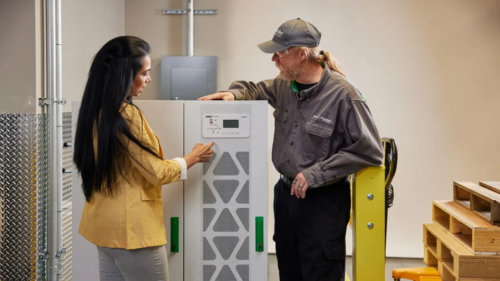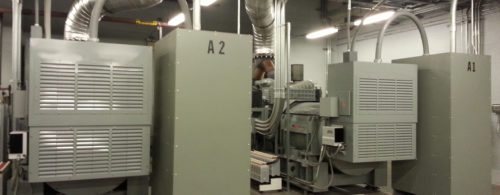Compressor Retrofit for Operating Engineers Building
If you’re a union pension trust fund that owns real estate and demands the highest level of operating efficiency for your buildings, you need to continually implement cutting edge energy conservation measures. You do this to maximize the long term financial performance of the investment. If you work for the Operating Engineers Pension Trust, Local 12, Pasadena, Calif., you’d better be the best when it comes to HVAC systems optimization and performance. As the Chief Engineer for this fund, Bruce Manning admits to being obsessed with finding ways to minimize energy use in his building.
Manning reports that a compressor retrofit has opened the door to additional cooling savings. He predicts these could be as high as 50% to 70%.
The four-story office building was completed in 1988 and encompasses 210,000 gross sq. ft. The heart of the original cooling system was two 120-ton open drive reciprocating compressors connected to a built-up direct-expansion (DX) coil with sixteen expansion valves. Conditioned air is delivered to four floors of VAV boxes from the centralized penthouse air-handling system with dual, side by side DX coils and associated face off dampers, variable speed driven supply and return air fans.
The system also features a fully functional 100% air outside air (OA) enthalpy controlled economizer system. Manning, a 30-year engineering and energy analysis veteran, took over in 1993 and performed extensive maintenance management and energy management evaluations of the entire real estate portfolio including this facility.
Over time, Manning installed VFDs on the supply and return fans and cooling tower fans to conserve energy by eliminating the previous constant volume fan systems operation with inlet guide vane control. He then retrofitted and overlaid a point-intensive DDC energy management control system on all mechanical equipment and floor VAV boxes. Manning developed his “energy report card,” which utilizes kBtu/sq. ft. as the primary benchmark to evaluate and maintain the efficient energy utilization performance of his buildings.
After evaluating all possible plant retrofit options for years, he knew that additional efficiency improvements were possible, but not at the right cost/benefit and associated return on investment ratios. He became particularly interested in refrigeration compressor improvements and began studying and tracking a new low-friction, oil-free refrigeration compressor.
“I had been following the development of this technology since its inception,” says Manning. “I waited until a few local jobs were installed and went to look at and evaluate them.” He then discussed the design and performance of the jobs with various contractors, consulting engineers and on-site property engineering staffs.
Manning concluded that the chosen technology, with its oil-free design, variable frequency speed control, floating magnetic bearings, centrifugal compression and digital controls was the ideal replacement compressor for his building. “I was also influenced by the fact that with only one moving part, no need for lubrication and virtually no maintenance, both maintenance and energy costs could be very significantly reduced.”
Manning turned to ACCO Engineered Systems, a design-build contractor with a long history and experience with the product. He worked closely with Jacob Coble and Bill Brown of ACCO to design and install the compressors while at the same time optimizing his building’s HVAC system. “We were determined not to leave any energy savings potential on the table,” he says.
The new compressors are rated at 120 tons each, or 240 tons total. The installation was done in January 2006 and was completed over a few weekends. Manning says the startup went very smoothly. “We did the normal tuning and tweaking to prevent surge conditions on low load and verifying proper motor cooling at the specified compressor amperage at full load.
The HVAC system in this office building has eight electronic expansion valves (EXVs) on each of the two DX cooling coils to assure the appropriate flow of refrigerant during varying load conditions. According to Manning, he and Brown spent considerable care in the commissioning stage to assure that these EXVs were utilized properly in a “full face” coil feed control strategy. This strategy is used in conjunction with the building’s centralized energy management system and the compressors on board intelligence.
The electric utility, Pasadena Water & Power (PWP), was very supportive of the compressor upgrade, actually providing a rebate for the installation. PWP also worked with the owner to document the efficiency improvements.
Manning feels the most important aspects of the new compressors will be their “unparalleled efficiency that will finally enable a properly implemented and optimized system to match exactly the required horsepower and associated kW of the entire plant to the connected real-time air conditioning load.”
Asked what he would tell other owners contemplating such a compressor upgrade, he says he would urge them to visit other jobs. “There is still a learning curve to all this,” he cautions. “You need to develop a full sequence of operation for the entire system, not just the compressors, in order to take full advantage of all the operating efficiency doors that these compressors can open.”
For more about Danfoss Turbocor technology, click here .
Do you have experience and expertise with the topics mentioned in this content? You should consider contributing to our CFE Media editorial team and getting the recognition you and your company deserve. Click here to start this process.




